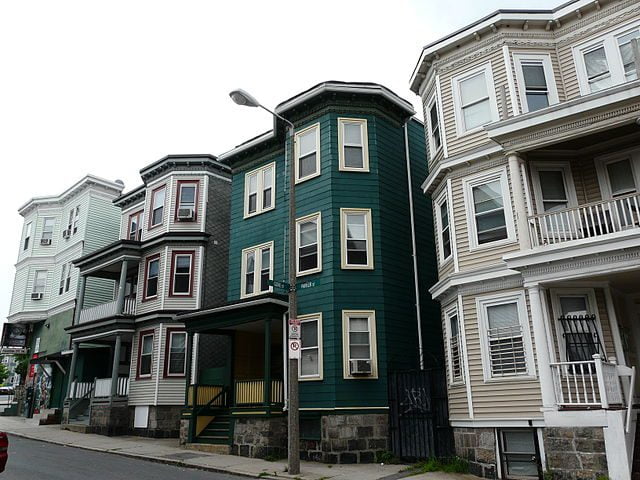The Triple-Decker: Boston’s Signature Building
Of all of Boston’s many architectural styles, few are as interwoven with the daily lives of its residents than the famous “three-decker” home. From South Boston, to Dorchester to Cambridge, from Salem to these split-level, multi-family homes are a staple of residential neighborhoods.
According to Madeline Bilis of Boston Magazine, the three-decker (or “triple decker,” as it’s also known) has five distinct features: multiple street-facing bay windows, a hexagonal column facing the street, flat roofs, wooden construction, and a single entrance.

The flat roof, the single entrance, and the hexagonal column are staples of the famous Boston apartment building. Photo by Roman Eugeniusz [CC BY-SA 3.0], via Wikimedia Commons
The Windows of the Three Decker are Windows to Boston’s Past
The three-story homes played an interesting role in Boston’s development. After the Civil War, when waves of Irish and other European immigrants came into the city, demand for housing skyrocketed. Some East Coast cities built new housing stock with more expensive, but considerably less fire-resistant, brick and concrete. You can see that kind of construction in the row houses of New York, Baltimore, and Philadelphia.
Boston, on the other hand, opted for wood, a cheaper material, for the distinctive three-deckers. The new homes allowed Boston’s neighborhoods to house many residents in relatively small areas of land. In the era before skyscrapers, this is how urban areas packed in as many residents as possible.
As more high-end condominiums and other buildings spring up, many residents wonder if they can afford to live here. But these historic and abundant buildings can still offer a somewhat less expensive rental option. And while nobody would call Boston a cheap place to live, rents have been stabilizing in the past few years, making these neighborhood homes all the more attractive.
You can read the full Boston Magazine article here.
Ready to move into a Boston three-decker of your own? Get a quote from Boston’s best movers today!
Featured Photo by Piotrus [GFDL or CC BY-SA 3.0], via Wikimedia Commons

